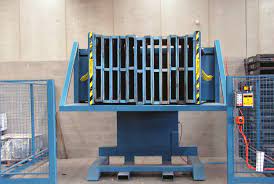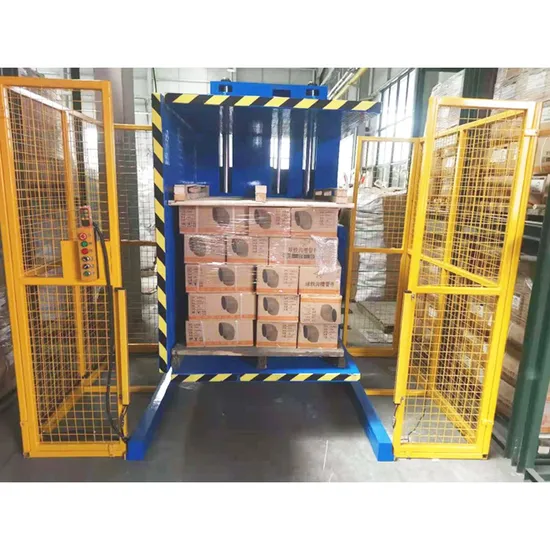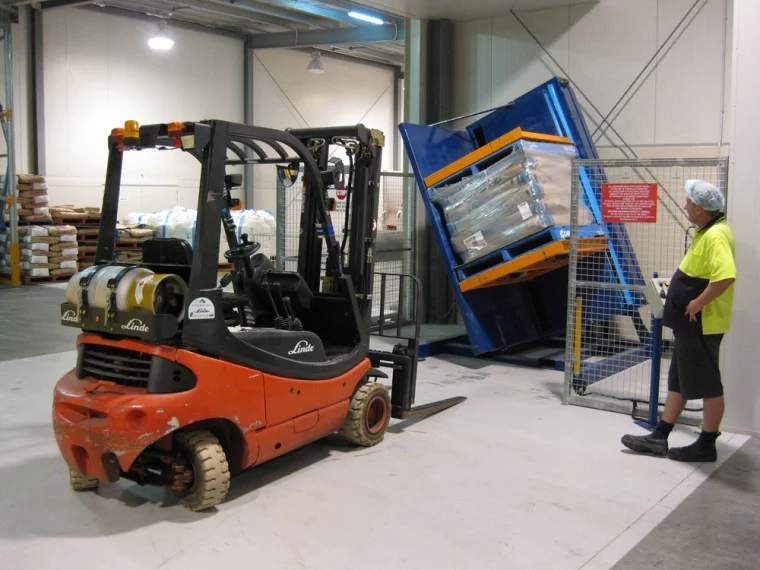What’s the ROI of Automated Pallet Changing Machines in Saudi Arabia's heat-resistant Sector?
Are you managing a facility in Saudi Arabia's heat-resistant sector? You probably deal with heavy, often specialized, materials every day. The manual process of changing pallets is slow, physically demanding, and a constant source of operational bottlenecks. This inefficiency isn't just a minor annoyance. It directly translates to higher labor costs, increased risk of product damage, and potential worker injuries, all of which eat away at your bottom line in a highly competitive market.
Investing in an automated pallet changing machine offers a substantial Return on Investment (ROI) by directly tackling these challenges. For most operations in Saudi Arabia's heat-resistant sector, the ROI comes from a combination of drastically reduced labor costs, increased throughput, minimized product damage, and enhanced worker safety. A typical payback period for this equipment ranges from 12 to 24 months, making it a financially sound strategic investment for improving operational efficiency and profitability.

I’ve spent my entire career in the packing machine industry, first as an engineer and now as a factory owner. I've seen firsthand how a single piece of smart automation can transform an entire production line. It's not just about a new machine; it's about a new way of thinking about your workflow. You might be wondering how these savings break down and if they are realistic for your specific situation. Let's dig into the details and explore the real-world impact of this technology.
How Do Pallet Changers Directly Reduce Operational Costs in a Demanding Environment?
Your operational budget is under constant pressure. High labor costs, the need for multiple forklifts, and slow manual processes are likely some of your biggest concerns. This problem gets worse in demanding environments like the heat-resistant sector, where you might use heavy or non-standard pallets. You hear that an automated system can save you money, but you need to see the hard evidence. How exactly does a machine turn its gears into real, tangible cost reductions?
An automated pallet changer reduces operational costs in three primary ways: it cuts down on the manual labor hours required for pallet transfers, it minimizes the reliance on and operational time of expensive equipment like forklifts, and it dramatically increases the speed and throughput of your entire logistics process. This leads to direct and measurable savings in wages, fuel, maintenance, and overall operational time.

Dive Deeper: Breaking Down the Cost Savings
When I work with clients like you, we don't just talk about features. We talk about numbers. A pallet changer isn't a cost center; it's a profit driver. Let's break down exactly where the savings come from.
Labor Cost Reduction
This is the most immediate and obvious saving. A manual pallet change often requires two workers and a forklift. The process can take several minutes. An automated pallet changer, on the other hand, can be operated by a single person in under a minute. The machine does all the heavy lifting. Your team member simply loads the pallet and pushes a button. This frees up your skilled workers to focus on more value-added tasks instead of manual labor. In an environment like Saudi Arabia, where skilled labor is a valuable asset, this reallocation of human resources is a significant operational win.
Reduced Equipment and Maintenance Costs
Every time a forklift is used for a pallet swap, it consumes fuel or electricity, and its components—tires, forks, hydraulic systems—suffer wear and tear. These costs add up quickly across thousands of cycles. An automated pallet changer is a stationary piece of equipment designed for one specific, repetitive task. Its energy consumption is predictable and generally lower than a forklift's, and its maintenance is scheduled and less intensive. By reducing the dependency on forklifts for this task, you extend their operational life and lower their maintenance budget.
Increased Throughput and Efficiency
Time is money. A slow pallet changing process creates a bottleneck that can hold up your entire shipping or receiving department. If trucks are waiting, you could face detention fees. If your production line is starved of materials, you lose output. Automation solves this. A pallet changer can swap a pallet in about 60 seconds. This speed and consistency allow you to process more goods in the same amount of time, increasing your facility's overall throughput and capacity.
Here is a simple comparison:
| Metric | Manual Pallet Changing | Automated Pallet Changing |
|---|---|---|
| Personnel Required | 2 Workers + 1 Forklift Operator | 1 Operator |
| Time per Pallet | 5-10 Minutes | ~1 Minute |
| Forklift Use | Continuous | For loading/unloading machine only |
| Consistency | Varies by team | Highly consistent |
| Risk of Bottleneck | High | Low |
For a business owner, these are not small details. They are the core components of a lean and profitable operation.
Can Automated Pallet Changing Improve Worker Safety and Reduce Product Damage?
As a CEO, your responsibilities go beyond the balance sheet. A single workplace accident can have devastating human consequences and cause significant financial and reputational damage. Similarly, a shipment of damaged goods arriving at your customer's site hurts your credibility. Manual handling of heavy loads, especially in the heat-resistant sector where products can be dense and unwieldy, is a major source of both these risks. Can a machine truly solve these very human problems?
Yes, automated pallet changers are one of the most effective tools for improving worker safety and protecting products. By automating the lifting, tilting, and transferring of loads up to 2000 kg, they eliminate the manual labor that causes most back injuries and strains. At the same time, their controlled, gentle clamping mechanism secures the load throughout the process, preventing the slips, drops, and impacts that often occur during manual or forklift-based transfers.

Dive Deeper: A Dual Focus on People and Products
Early in my career, I saw an incident where a worker seriously injured his back trying to manually restack heavy bags from a broken pallet. The company faced a costly compensation claim, but more importantly, a valued employee suffered a life-altering injury. That event convinced me that good engineering must always prioritize safety. An automated pallet changer is a perfect example of this principle in action.
Eliminating Manual Handling Risks
The number one cause of workplace injuries in logistics and manufacturing is overexertion, specifically from lifting, pushing, and pulling heavy objects. This is a well-documented fact. A manual pallet swap involves all these risky movements. Workers have to bend, twist, and lift, often in awkward positions. An automated pallet changer takes the worker out of the equation. The machine bears the entire load. The operator's job is supervisory, not physical. This simple change in process design nearly eradicates the risk of musculoskeletal injuries associated with this task.
Securing Product Integrity
Your products are the lifeblood of your business. Damage during internal handling is a pure loss. When a forklift driver tries to transfer a load from one pallet to another, several things can go wrong. The forks can puncture the product, an unstable load can shift and fall, or a sudden stop can cause damage. An automated pallet changer is designed for stability. It clamps the load securely from the top and sides before it begins its rotation. The movement is smooth and controlled. This ensures the product stack remains intact and stable, free from the shocks and vibrations of a manual transfer. For high-value goods in the heat-resistant sector, this reduction in damage can lead to savings of tens of thousands of dollars annually.
Let's compare the risk profiles:
| Risk Factor | Manual/Forklift Transfer | Automated Pallet Changer |
|---|---|---|
| Worker Injury | High (back strain, repetitive motion) | Very Low (operator is supervisory) |
| Product Punctures | Moderate (forklift tine errors) | None (uses pressure plates) |
| Load Instability | Moderate (sudden movements) | Low (secure clamping and smooth rotation) |
| Process Control | Low (depends on operator skill) | High (programmed and repeatable) |
Investing in safety and quality isn't an expense; it's a strategy. It protects your people, your products, and ultimately, your brand's reputation.
What is the Typical Payback Period for a Pallet Changer Investment in Saudi Arabia?
You are a practical business leader. You understand that every investment must be justified with a clear and compelling return. "It saves money" is a good start, but you need to know how much and how fast. When you sign a purchase order for a new machine, you need a confident answer to the question: "When will this investment pay for itself?" Vague promises are not enough; you need a timeline based on real data from your operations.
For most medium-to-high volume operations in Saudi Arabia, particularly in demanding sectors like heat-resistant materials, the typical payback period for an automated pallet changer is between 12 and 24 months. This rapid return is driven by significant, quantifiable savings in labor costs, a sharp reduction in product damage expenses, and increased operational throughput. The exact period depends on your specific labor rates, product value, and daily pallet-swapping volume.

Dive Deeper: Calculating Your Specific Payback
As an engineer, I believe in showing the math. A payback calculation isn't complex, but it requires you to be honest about your current costs. Let's build a sample case for a hypothetical facility in Saudi Arabia.
Step 1: Calculate Your Initial Investment
This is more than just the price of the machine. A responsible supplier will provide a transparent quote that includes everything.
- Machine Cost: The base price of the pallet changer.
- Shipping & Installation: The cost to get it to your facility and set it up.
- Training: Ensuring your team can operate it safely and efficiently.
- Total Initial Investment (A)
Step 2: Quantify Your Annual Savings
This is where you analyze your current operational costs that will be eliminated or reduced.
- Annual Labor Savings (B): Calculate the wages of workers who will be freed up. (Number of workers) x (Hours per day on this task) x (Hourly wage) x (Working days per year).
- Annual Product Damage Savings (C): Estimate the value of product lost or damaged during pallet transfers each year. Even a conservative 1% reduction can be substantial.
- Other Savings (D): Include reduced forklift maintenance, lower risk of injury claims, etc.
- Total Annual Savings (E) = B + C + D
Step 3: The Payback Formula
The formula is simple: Payback Period (in years) = Total Initial Investment (A) / Total Annual Savings (E)
Let's use some sample numbers for a Saudi facility:
| Calculation Item | Description | Example Value (SAR) |
|---|---|---|
| (A) Total Investment | Machine + Shipping + Install | 250,000 |
| (B) Labor Savings | 1.5 workers reassigned (@ 5,000/mo) | 90,000 / year |
| (C) Damage Reduction | Reduced damage on high-value goods | 40,000 / year |
| (D) Other Savings | Forklift maintenance, safety buffer | 15,000 / year |
| (E) Total Annual Savings | B + C + D | 145,000 |
| Payback Period | A / E (in years) | 250,000 / 145,000 = 1.72 years |
In this realistic scenario, the payback period is just over 20 months. After that, the 145,000 SAR in annual savings goes directly to your profit margin, year after year. This is the kind of clear, data-driven case that justifies a capital investment.
How Does Automation in Pallet Handling Align with Saudi Vision 2030's Goals?
As a business leader in Saudi Arabia, your strategy can't exist in a vacuum. You operate within the framework of Saudi Vision 2030, a transformative national plan. Every major investment decision should be viewed through this lens. Is this equipment purchase simply a short-term fix, or does it position your company as a modern, forward-thinking contributor to the Kingdom's long-term economic goals?
Investing in automated pallet handling aligns perfectly with the core pillars of Saudi Vision 2030. It directly supports the vision's goals of boosting industrial productivity, diversifying the economy, developing a skilled local workforce, and establishing the Kingdom as a global logistics hub. This technology is not just about improving your factory; it's about building a more competitive and technologically advanced industrial sector for Saudi Arabia.

Dive Deeper: A Strategic Investment in the Future
When I meet with forward-thinking leaders like you, our conversation often moves beyond simple ROI. We talk about future-proofing the business. Aligning your technology with national strategy is a powerful way to do that.
Boosting Productivity and National Competitiveness
A key goal of Vision 2030 is to move the economy away from its reliance on oil by creating a robust and competitive industrial sector. Competitiveness is built on efficiency. Automation is the engine of efficiency. By replacing slow, manual processes with fast, reliable automated systems like pallet changers, Saudi companies can produce and ship more goods at a lower cost. This makes them more competitive not just locally, but on the global stage. It transforms facilities from simple production sites into highly efficient nodes in the international supply chain.
Developing a Skilled Workforce
Vision 2030 is not about replacing people with machines; it's about elevating people's skills. Automation eliminates monotonous, physically taxing, and low-skill jobs. This frees up the national workforce to be trained for higher-value roles: machine operators, maintenance technicians, quality control specialists, and logistics planners. An investment in a pallet changer is also an investment in your team. You are shifting them from manual labor to technology operation, which is the exact kind of workforce development the Kingdom is championing.
Enhancing Logistical Hubs
Saudi Arabia's geographic location makes it a natural logistics crossroads. Vision 2030 aims to capitalize on this by creating world-class logistical infrastructure. This infrastructure isn't just about ports and roads; it's also about the technology inside the warehouses and factories. Fast and efficient pallet handling is critical for reducing truck turnaround times, speeding up container loading, and ensuring the smooth flow of goods. By adopting this technology, your company becomes a stronger link in this national logistics chain, contributing directly to the vision of a globally significant hub.
Investing in a pallet changer is a vote of confidence in a more productive, more advanced, and more prosperous future for the Saudi industrial landscape.
My Insights
I've been in this industry for over 25 years. I started on the factory floor and eventually built my own company, SHJLPACK. I’ve seen what works and what doesn't. When we talk about equipment like a pallet changer, I want to share a perspective that goes beyond the sales brochure.
First, this is not just about buying a machine. It's about adopting a new operational philosophy. The real value comes when you see this machine as the heart of a more streamlined process. The data it provides—cycles per hour, uptime, fault codes—is gold. For a leader like you, who is focused on digital transformation, this is your first step toward a fully visualized production line. You can connect its output to your MES and start making data-driven decisions about your logistics flow.
Second, don't try to boil the ocean. If you have multiple lines, start with one. Install a pallet changer on your most challenging or highest-volume line. Use it as a pilot project. Let your team get comfortable with it. Measure the results meticulously: track the reduction in time, the drop in product damage, and the feedback from your workers. The success of that single project will provide an undeniable case study to justify further investment. The numbers will speak for themselves.
Finally, the partner you choose is as important as the machine you buy. You need more than a supplier; you need a partner who understands your industry, who can advise you on the right configuration, and who will be there to support you after the installation. My journey taught me that success is built on relationships and shared knowledge. That’s why I founded SHJLPACK on the principle of being a total solution provider. We don't just sell machines; we share our expertise to help your business grow.
Conclusion
Ultimately, an automated pallet changer in Saudi Arabia's heat-resistant sector is a strategic investment with a clear, rapid ROI, enhancing efficiency, safety, and your alignment with Vision 2030 goals.


